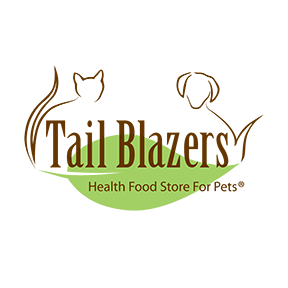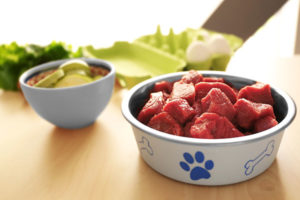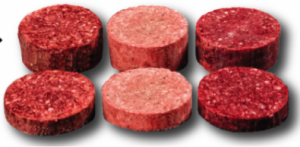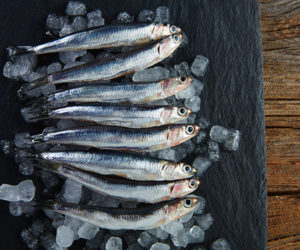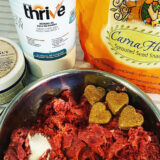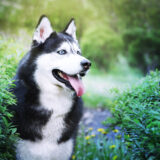Choosing A Raw Bone For Your Pet
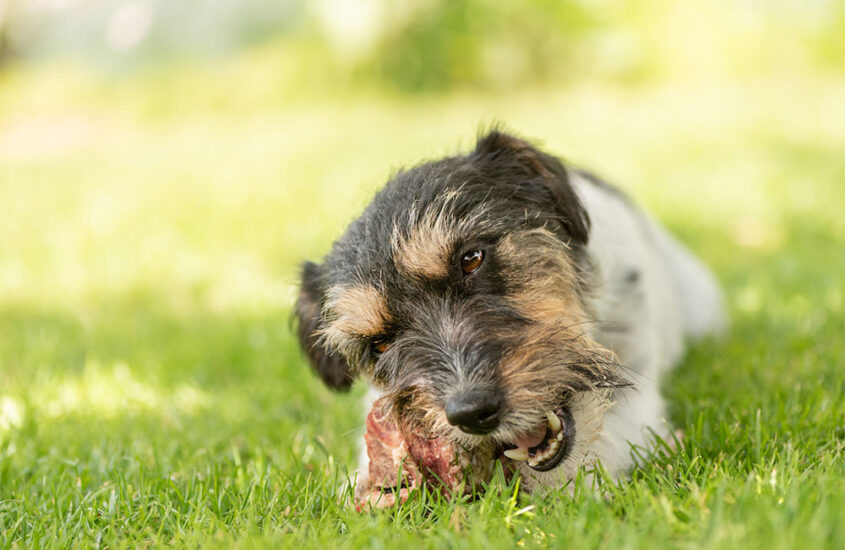
Today we will be guiding you through picking an appropriate RAW bone for your pet!
Yes, there is a right and wrong to picking an appropriate chew for your pet and the biggest concern is that the chew may be too small for your pet but it can also be too large or too hard.
Meal Replacement VS Recreational
You may hear this often in the pet food industry, but what is a meal replacement bone and what is a recreational bone?
So a meal replacement bone is just that. A ‘bone’ that is meaty enough to replace a meal. This could range based on the size of your pet but really has to do with the meat content attached to the bone. Any sort of neck, foot, whole fish, tail, or bone that is meant to be entirely consumed is a meal-replacement bone. You can actually use these to feed as a meal to your pet rather than putting down a bowl of food.
A recreational bone is meant for intense chewing. They may be mostly hard bone and have less meat on them, however still have some meat. These are more common for larger dogs who have stronger teeth to break down the rough bone and can be identified as: marrow bones, patella bones, knuckles, necks, and ribs. Smaller dogs can chew on small marrow bones and small rib bones as well. Most often these bones will not be completely consumed. If the bone has enough meat content available on it you can use it as a replacement bone or you can simply use a bone like this on a fasting day to keep the mind of your pet occupied.
Why are bones important for your pet?
Bones have so many benefits for your pet.
- One of the best benefits is dental health. If you are feeding bones appropriately, they can do wonders for dental health. Necks can act as a natural floss, and harder bones can help scrape tartar off of teeth. Feeding a bone once a week can have a huge effect on your pet’s dental health
- Mental Stimulation. Rainy day? Can’t make it out for a walk or to the dog park? Give your pet a bone instead! Your pet eating a bone is the equivalent of going for a walk or a run. Recreational bones can give your dog a full body workout, just watch them chew it. They are using every part of their body. They are using their paws to pin the bone down, and their jaw to chew, but their whole body is engaged in ripping and gnawing.
- Natural Habits. Allowing your pet to chew often on something appropriate will actually help release frustration that they may have. If your pet is a destructive chewer, bones are really helpful in this situation.
- Calcium. Grinding on bones and eating bones fully can help increase the calcium intake your pet is getting. This is why it is so important for puppies to eat bones regularly. They need that calcium to grow!
Can cats eat bones?
Yes, cats can eat bones! Cats are so good at chewing – you may notice that they practice chewing on things in your home you prefer they didn’t, like your chargers, television cords, wood, cardboard, and plastic. These are all things that we would want to discourage them from chewing on, so using a redirecting chew can be beneficial.
Here is a list of items that are appropriate raw chews for cats:
- Chicken necks
- Small chicken feet/wings
- Whole quail parts
- Cornish hen parts
- Rabbit feet and ears
- Small rodents (if available)
Think of what your cat would likely hunt/eat in the wild. Small-winged prey have softer bones that are small and easy for your cat to digest, but not too small that it causes a choking hazard. These are all also great options for kittens (and the younger you start the more into it they are as an adult cat).
Here’s a few items we would suggest staying away from:
- Beef neck bones
- Marrow bones
- Turkey necks
- Knuckles
These bones are just too big for your cat. Bones that are too big or hard can cause dental damage or blockages in your pet’s digestive system.
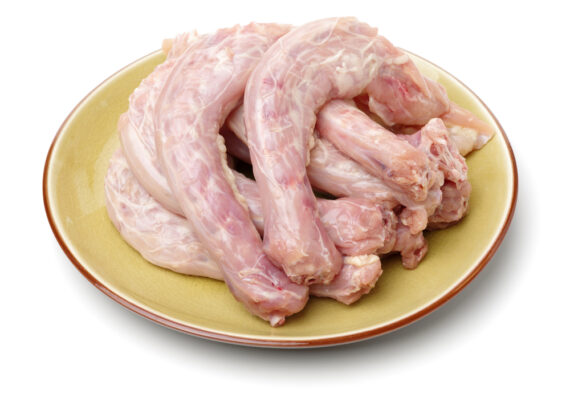
One of the dogs’ favorite pastimes is chewing. So let’s pick out some of the best chew options for dogs.
Puppies 8 weeks – 6 months | |
A puppy’s calcium and phosphorus requirements are higher than that of an adult dog because of all the growing they have to do in their first year of life. Most puppies should consume anywhere from 15-20% bone content daily. Small breed puppies can eat:
Medium breeds:
Large & Giant breeds:
| Avoid: Recreational chewing bones. Anything that is too hard for their little puppy teeth! As well as anything that is smaller than their throat – puppies can be rambunctious and insatiable. If they are food determined they may attempt to swallow these smaller bones whole. |
Extra Small Dogs 10-20 lbs | |
Extra small dogs will have similar chewing options to cats. So this includes:
| |
Small Dogs 25-35Ibs | |
Small dogs will have a larger variety of chewing options to extra small dogs. This includes:
| |
Medium Dogs 40-60lbs | |
Medium dogs have many options in chews, but also a few to avoid as they may cause choking hazards.
| Avoid as it may pose a choking hazard: Chicken necks, feet, wings |
Large Dogs 65-85LB | |
Large dogs have a large variety of raw bone options.
| Avoid as it may pose a choking hazard:
|
XL Dogs 90-100+LBS | |
XL dogs have quite a few bone options.
| Avoid as it may pose a choking hazard:
|
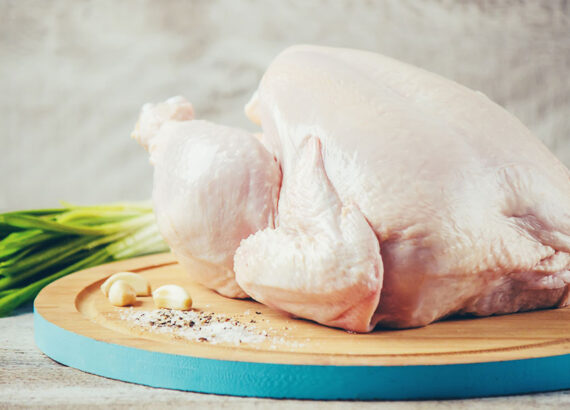
Hazards
The hazard section is just that, a hazard. Not meaning that you should always stay away from it, but if you are going to feed ask yourself a few questions before such as:
1. Is my pet going to eat this slowly and appropriately, or will they try to swallow it whole?
2. If my pet starts choking, do I have the ability to help them? Will they allow me to help them? A scared pet can be a dangerous one.
Better to be safe than sorry, and only feed your dog bones that are sized appropriately for them. It is important to note that every pet is different. If your pet gets highly excited and eats too quickly when feeding bones then smaller bones like necks, feet, and backs may want to be avoided or crushed before being given to the pet to avoid the possibility of choking. I have heard about a few small dogs (usually cocker spaniels) getting chicken necks caught in their throat because of excitement/not chewing it or competition to eat it fast because another dog is present. Know your dog and its boundaries and if it’s your first time giving a bone, make sure you are beside them the whole time and maybe even hold onto the end of it to be sure they are being safe.
*** A note on marrow bones. Please make sure that you are getting the appropriate size. Your dog’s bottom jaw should not be able to fit into the middle of the marrow bone. Sometimes people think it is not harmful to go a size up with bones but with marrow bones specifically, it is quite concerning.
Questions/Concerns:
1. How often should I be giving my cat a bone?
Cats can have bones 1-2 times per week. Any more bone content could make them constipated.
2. How often can I give my Puppy a bone?
Puppies can eat bones 2-3 times per week. This is a bit more than an adult dog because they require more calcium to grow. Puppies should not be eating HARD bones or recreational chewing bones until their adult teeth are in – their puppy teeth are too delicate for hard bones.
3. How often can I give my adult dog a bone?
Similar to adult cats, dogs should be eating no more than 2 bones a week. Any more than this your dog could experience constipation from too much bone content.
4. Can I give my senior dog a bone?
Yes, senior dogs can eat bones. If you are worried about this because the animals’ teeth have been compromised, we would suggest keeping that senior pet on the meal replacement side of bones, and also ensure they are completely thawed before giving it to them so they aren’t too hard or too cold (pets are sensitive too). If the senior pet does not have any dental concerns they should be able to eat a variety of bones.
5. Can I leave my pet alone with a bone?
We would never recommend leaving a pet alone with any chew or bone. It’s a risk to leave an animal alone with a chew, even if they have chewed on the same type of bone a dozen times without issue. Raw bones are less likely to splinter however it’s not completely unheard of. Neck bones and rib bones have smaller chunks of bones that can break off and become choking hazards. Also, the last chunk of any meal replacement bone can be a concern as well, so throw the end piece away or keep a very close eye on your pet at this stage. Always take away the last piece or the finished product of a recreational chewing bone, these bones tend to get harder if they are left around for a few days.
6. Can I give my pet a smoked bone with the same benefits?
Smoked bones do not have the same benefits as raw bones. Although some are more natural, many smoked bones have added color and flavor, and since they are cooked they are much more likely to splinter. They will not clean the teeth the same way a raw bone would either.
7. Can I cook the raw bones before I feed them?
Yes, raw bones can be cooked, but only for use in a BONE BROTH. Feeding the cooked raw bone after is both more dangerous because of the increased risk of splintering and it is also lacking in the nutritional benefits of the raw bone. Raw bones are great to make a natural pet bone broth at home, but they will not do much for your pet chew-wise.
We hope that you enjoyed our raw bone blog, and that you were able to pinpoint exactly what you can give your pet for a meal replacement and recreational chew and show you the importance of adding raw bones to your pet’s diet. You can add these bones even if you aren’t feeding a fully raw diet, as they are a great addition to any cat and dog diet. If you have any further questions or concerns about raw bone safety or appropriateness for your pet, visit a Tail Blazers location near you and experience the benefits of your pet being Tail Blazers healthy.
